Pine, spruce or fir: Getting to know Michigan evergreen trees
Be a smart gardener and learn how to identify pine, spruce and fir trees.
Three of the most common conifers grown in Michigan are pine (Pinus spp.), fir (Abies spp.) and spruce (Picea spp.) trees. They are all evergreen, pyramidal and have similar foliage color. Homeowners often get them confused, but smart gardeners know the difference in order to properly time their pruning as well as diagnose any specific ailments.
Which is which?
To separate the different types of conifers from one another, Michigan State University Extension recommends gardeners start by looking closely at the needles. Observe whether individual needles are attached to the stem or if they are in clusters (fascicles). Next, try to roll the needles between your fingers to determine if the needles are flat or rounded. Finally, determine if needles are attached directly to the stem or a wooden peg-like structure.
The nitty gritty
Pines (Pinus spp.) bear needles in clusters of two, three or five needles, depending on the species. Their needles may be long or short, but if you find needles in clusters, you have a pine tree.

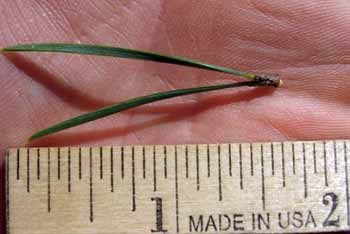
Left, White pine has five needles per cluster. Photo credit: Mary Wilson, MSU Extension. Right, Scotch pine – needles are two per cluster. Photo credit: Keith Kanoti, Maine Forest Service, Bugwood.org
Spruce (Picea spp.) needles, on the other hand, are attached individually to the stem. Also, spruce needles are sharply pointed, square and easy to roll between your fingers. Another important distinguishing feature is that spruce needles are attached to small, peg-like wooden structures. When the needles are shed, these projections remain and the spruce branches feel rough.

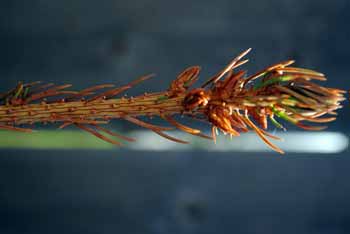
Left, Spruce with single needles attached to stem. Right, Spruce stem showing peg-like wooden structures. Photo credits for both: Mary Wilson, MSU Extension
Fir (Abies spp.) needles, like spruce, are attached individually to the branches. However, unlike spruce, fir needles are soft, flat and cannot be rolled between your fingers. Fir branches lack any peg-like wooden structure on the stem and thus have smooth bark. When the needle is pulled off the stem, a small, circular leaf scar is left behind.
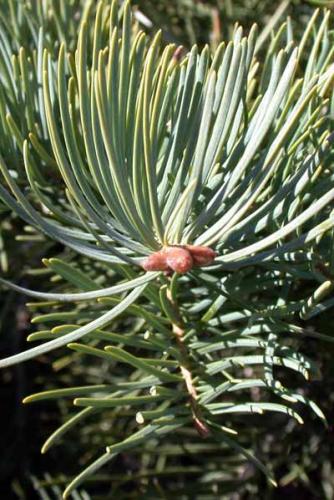
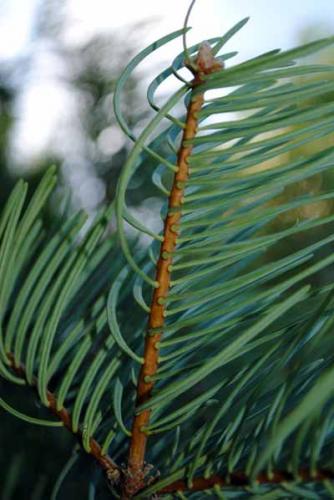
Left, Flat needles of fir. Photo credit: Rebecca Finneran, MSU Extension. Right, Base of a fir needle is circular and not attached to a wooden peg. Photo credit: Mary Wilson, MSU Extension
Additional clues
The cones of these conifers offer up the most obvious clues. Cones are made up of scales attached to a center stalk and knowing whether they are rigid or flexible helps differentiate between pine and spruce. Whether the cones are held upright or droop on the branches and if they fall whole from the tree or in pieces can also be helpful identification traits.
Pine cone scales are woody while spruce cone scales are thinner and more flexible. Pine and spruce cones hang down while fir cones stand erect on tree branches. Also, both pine and spruce cones typically fall whole from the tree while fir cones break apart while on the tree. One often finds pine and spruce cones on the ground while discovering fir cones there is rare.
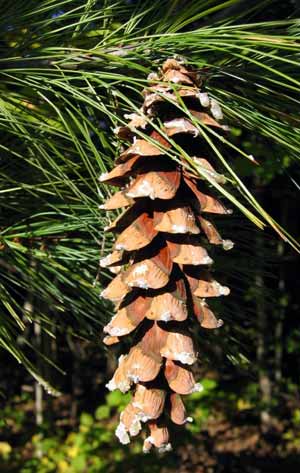

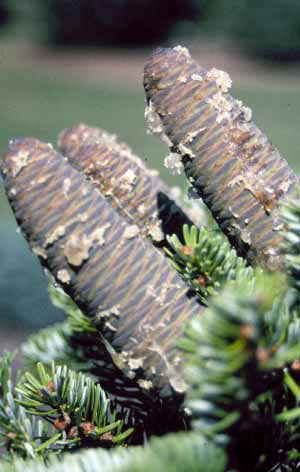
Left, Pine cone scales are woody with a rigid feel. Photo credit: Keith Kanoti, Maine Forest Service, Bugwood.org. Middle, Spruce cones have thinner and more flexible scales than pine cones. Photo credit: Robert Videki, Doronicum Kft., Bugwood.org. Right, Fir trees have upright cones that “shatter” on the plant. Photo credit: Bert Cregg, MSU
For more information on a wide variety of smart gardening articles, or to find out about smart gardening classes and events, visit www.migarden.msu.edu.



 Print
Print Email
Email




